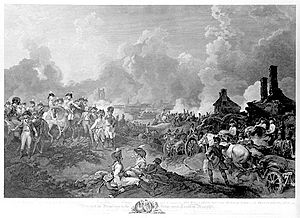Siege of Valenciennes (1793) facts for kids
Quick facts for kids Siege of Valenciennes (1793) |
|||||||
|---|---|---|---|---|---|---|---|
| Part of the Flanders campaign in the War of the First Coalition | |||||||
 The Grand Attack on Valenciennes by the Combined Armies under the Command of His Royal Highness the Duke of York, 25 July 1793, Philip James de Loutherbourg |
|||||||
|
|||||||
| Belligerents | |||||||
| Commanders and leaders | |||||||
| Strength | |||||||
| 80,000 | 10,000 | ||||||
| Casualties and losses | |||||||
| Unknown | Unknown | ||||||
The Siege of Valenciennes was an important battle that happened in 1793. It took place in the city of Valenciennes, France. This siege was part of a bigger conflict called the War of the First Coalition.
During the siege, French soldiers defended the city. They were led by a commander named Jean Henri Becays Ferrand. An army of different countries, called the Allies, surrounded Valenciennes. This Allied army was commanded by Prince Frederick, Duke of York and Albany. The siege lasted from June 13 to July 28, 1793. In the end, the Allied forces won the battle.
Why the Siege Happened
After a major battle at Neerwinden, the French army was defeated. The Allied army, led by the Prince of Coburg, took back many areas. These areas were part of what was then called the Austrian Netherlands.
The Allies then began to surround another French fortress. This was the fortress of Condé-sur-l'Escaut. The French tried to help their soldiers inside Condé, but they failed. By May, the Allied army grew very strong, with about 90,000 soldiers. This allowed them to push the French out of a fortified camp. This happened at the Battle of Famars on May 23.
Many French soldiers who left Famars went to Valenciennes. This made the city's defense much stronger. The Prince of Coburg chose the Duke of York to lead the attack on Valenciennes. The Duke of York was from Great Britain. He had 14,000 Austrian soldiers helping him. An Austrian general, Joseph de Ferraris, helped with the technical parts of the siege.
The British government was surprised by this choice. British soldiers were not very experienced in long sieges. They also did not have the right equipment. Some even thought the Austrians had a secret reason for choosing the Duke of York. Colonel James Moncrief, the Duke of York's chief engineer, thought they could attack the city quickly. However, General Ferraris wanted a slow, formal siege. This meant digging long trenches and following strict procedures.
How the Siege Unfolded
It took two weeks to bring the heavy cannons forward. Finally, on June 13, the trenches were dug. The siege officially began. About 25,000 soldiers worked on the siege. Another 30,000 soldiers protected them from outside attacks.
The Austrian soldiers worked very slowly. This made the Duke of York frustrated. He complained to them, and they told him he was too eager.
On July 26, the Allies attacked the main defenses on the eastern side of the city. Three groups of soldiers stormed these defenses. One of these groups was made up of British troops. They were supported by other soldiers. The Duke of York's chief of staff, Murray, said that the British kept control of the defenses. He said this was because the Duke of York was leading them. General Ferraris had ordered them to leave the defenses. But Murray, knowing the Duke's wishes, gave orders to stay. The Duke of York fully approved of this decision.
After these defenses fell, Valenciennes surrendered on July 28. The French soldiers were allowed to leave the city. They could keep their honor, but they had to leave their weapons behind.
After the Battle
The people of Valenciennes were very happy about the Allied victory. They saw the Duke of York as a hero. They even trampled the French flag and cheered for him as if he were their king.
Images for kids
-
The Grand Attack on Valenciennes by the Combined Armies under the Command of His Royal Highness the Duke of York, 25 July 1793, Philip James de Loutherbourg


